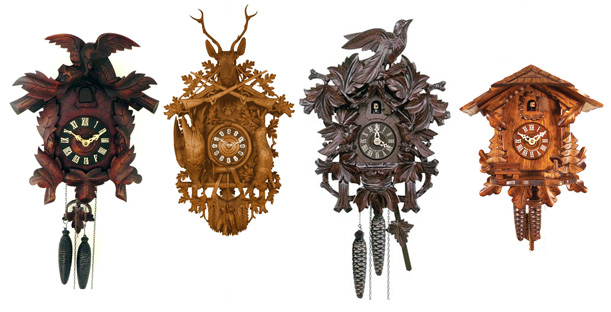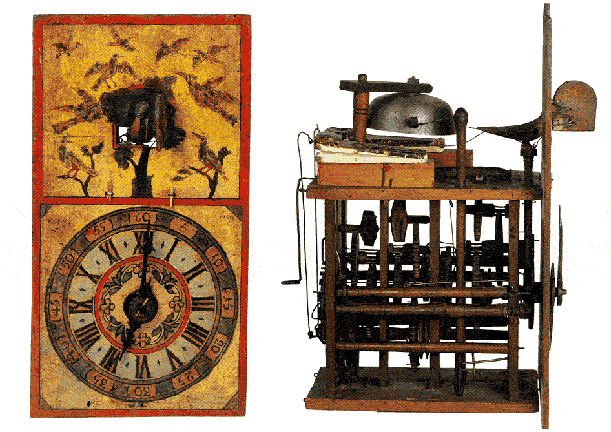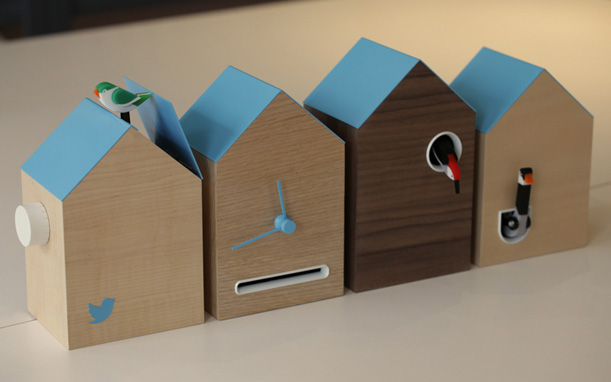The Past, Present, and Future of the Cuckoo Clock
From Orson Welles to Twitter, a look into the classic time-telling relic from your grandparents’ attic
![]()

A selection of traditional cuckoo clocks
“Like the fella says, in Italy for 30 years under the Borgias they had warfare, terror, murder, and bloodshed, but they produced Michelangelo, Leonardo da Vinci, and the Renaissance. In Switzerland, they had brotherly love – they had 500 years of democracy and peace, and what did that produce? The cuckoo clock.”
So says Orson Welles as Harry Lime in the 1949 film The Third Man. Welles added those lines himself to a script based on Graham Greene’s original story. And though he may have been a genius, Welles was wrong about the history of the Cuckoo clock. “When the film came out,” he told Peter Bogdanovich, “the Swiss very nicely pointed out to me that they’ve never made any cuckoo clocks!” Indeed, although often associated with Switzerland, the cuckoo clock was more likely invented in Germany sometime in the 17th century. I use the word “likely” because the origins of the cuckoo clock are unclear and its invention is still a topic of debate among horologists.
For a long time, the cuckoo clock was attributed to Franz Anton Ketterer, a clockmaker of some repute from the Black Forest village of Schönwald. It was believed that Ketterer created the cuckoo in the 1730s, inspired by the bellows of church organs to adapt the technology in lieu of the chimes then typically used in clocks. This oft-cited theory first emerged in a relatively popular 1979 self-published book The Black Forest Cuckoo Clock. For such an iconic timepiece, there is surprisingly little written about the cuckoo clock, but, as recently noted by the National Association of Watch & Clock Collectors, modern scholarship does not support the Ketterer theory. While the full origins of the cuckoo clock remain unknown, evidence dates similar, though more primitive, objects to at least the mid 17th century – around 100 years before Ketterer’s supposed invention. In any case, the familiar cuckoo clock that we know and love today, the clock that hangs in our grandparents’ houses, was certainly developed and refined by the talented craftsman and clockmakers of the Black Forest.
In traditional cuckoo clocks, the “coo coo” sound is derived from a system of bellows pushing air through two wooden whistles to recreate the distinctive two-note call of the common cuckoo. The gears of these traditional cuckoo clocks are regulated by a pendulum and system of two or three weights, traditionally shaped like pinecones, that steadily drop over a period of one day or eight days, depending on the model of the clock. One weight, along with the pendulum, is dedicated to keeping the clock gears running while the other weight controls the avian automoton. Clocks that play music in addition to chirping will have a third weight. After a century of development that saw wood replaced with brass and metal, two distinct styles of cuckoo clock emerged from the Black Forest to dominate the market: The ornamented, house-like “Bahnhäusleuhr” or “railroad house” and the Jagdstück” or “Hunt piece” or “traditional style” clock, which features elaborate, decorative hand carved nature scenes adorning a simple encasement.
So why a cuckoo? The common cuckoo, native to Europe, had long served as a natural marker of time, a welcome harbinger of Spring whose familiar calls denoted the coming of the new season and warmer weather. Writing eloquently on the cuckoo in his 1849 book Natural History: Birds, English naturalist Philip Henry Gosse described the joy felt upon hearing the first coos of the season:
There are few who do not feel a thrill of pleasure when it falls upon their ear. But more especially when, for the first time in the season, it is heard in a lovely Spring morning, mellowed by distance, borne softly from some thick tree, whose tender, and yellow-green leaves, but half-opened, are as yet barely sufficient to afford the welcome stranger the concealment he loves. At such a time it is peculiarly grateful; for it seems to assure us that indeed, winter is past.
Over the centuries since it first emerged from the Black Forest, the cuckoo clock has remained largely unchanged. Traditional clocks can still be bought and are a popular souvenir. But of course, there are now a much wider variety of styles to choose from, including striking modern clocks that look more like abstract sculptures than timepieces. However, my favorite contemporary cuckoos are those that pay homage to traditional hand-carved “hunt piece.” Although all details have been stripped away and the elaborate carvings flattened onto a single surface, these modern cuckoos are instantly recognizable solely by their familiar silhouette.

An array of modern cuckoo clock designs. From left to right: Pascal Tarabay for Diamantini Domeniconi; IStime Modern Cuckoo Clock; a modern cuckoo clock from Urban Outfitters; Digital Cuckoo by Chris Koens
From “cuckoo” to “tweet tweet,” this next modern cuckoo clock is truly cutting edge. It was created by the London-based BERG design consultancy, who have a knack for integrating physical objects with digital network technology.
Designed especially for Twitter, #Flock is a series of four cuckoo clock objects that each literally “tweet” in response to a unique notification from the social media service. Berg’s method involves stripping an object down to its basic essence while maintaining a user-friendly, humanist design. Ornamentation was dropped in favor of a clean, minimalist design, an almost Bauhaus-like Bahnhäusleuhr. #Flock is a distillation of the cuckoo clock to three characteristics: craft, time, and alerts. #Flock is currently a limited edition exclusive to Twitter, but it alludes to a possible future where our digital lives are made manifest in the form of finely crafted objects and we interact with our invisible networks through real, physical things. But will it catch on? Will the cuckoo transform from the herald of Spring to the herald of retweets, emails, and likes? Only time (and tweets) will tell.
/https://tf-cmsv2-smithsonianmag-media.s3.amazonaws.com/accounts/headshot/Jimmy-Stamp-240.jpg)



/https://tf-cmsv2-smithsonianmag-media.s3.amazonaws.com/accounts/headshot/Jimmy-Stamp-240.jpg)